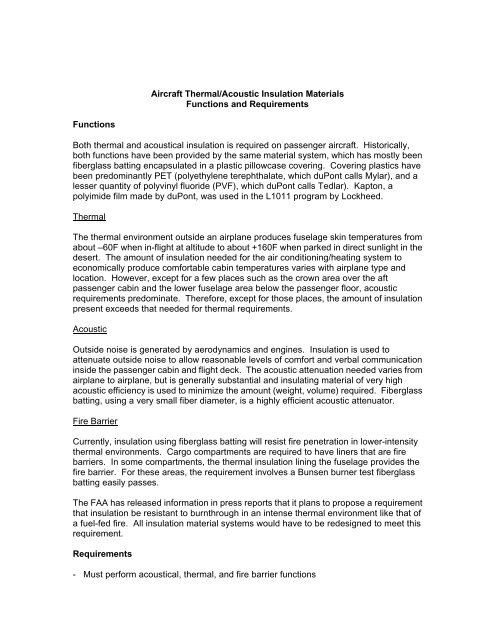Aircraft Thermal/Acoustic Insulation Materials Functions and ...
Aircraft Thermal/Acoustic Insulation Materials Functions and ...
Aircraft Thermal/Acoustic Insulation Materials Functions and ...
You also want an ePaper? Increase the reach of your titles
YUMPU automatically turns print PDFs into web optimized ePapers that Google loves.
<strong>Functions</strong><br />
<strong>Aircraft</strong> <strong>Thermal</strong>/<strong>Acoustic</strong> <strong>Insulation</strong> <strong>Materials</strong><br />
<strong>Functions</strong> <strong>and</strong> Requirements<br />
Both thermal <strong>and</strong> acoustical insulation is required on passenger aircraft. Historically,<br />
both functions have been provided by the same material system, which has mostly been<br />
fiberglass batting encapsulated in a plastic pillowcase covering. Covering plastics have<br />
been predominantly PET (polyethylene terephthalate, which duPont calls Mylar), <strong>and</strong> a<br />
lesser quantity of polyvinyl fluoride (PVF), which duPont calls Tedlar). Kapton, a<br />
polyimide film made by duPont, was used in the L1011 program by Lockheed.<br />
<strong>Thermal</strong><br />
The thermal environment outside an airplane produces fuselage skin temperatures from<br />
about –60F when in-flight at altitude to about +160F when parked in direct sunlight in the<br />
desert. The amount of insulation needed for the air conditioning/heating system to<br />
economically produce comfortable cabin temperatures varies with airplane type <strong>and</strong><br />
location. However, except for a few places such as the crown area over the aft<br />
passenger cabin <strong>and</strong> the lower fuselage area below the passenger floor, acoustic<br />
requirements predominate. Therefore, except for those places, the amount of insulation<br />
present exceeds that needed for thermal requirements.<br />
<strong>Acoustic</strong><br />
Outside noise is generated by aerodynamics <strong>and</strong> engines. <strong>Insulation</strong> is used to<br />
attenuate outside noise to allow reasonable levels of comfort <strong>and</strong> verbal communication<br />
inside the passenger cabin <strong>and</strong> flight deck. The acoustic attenuation needed varies from<br />
airplane to airplane, but is generally substantial <strong>and</strong> insulating material of very high<br />
acoustic efficiency is used to minimize the amount (weight, volume) required. Fiberglass<br />
batting, using a very small fiber diameter, is a highly efficient acoustic attenuator.<br />
Fire Barrier<br />
Currently, insulation using fiberglass batting will resist fire penetration in lower-intensity<br />
thermal environments. Cargo compartments are required to have liners that are fire<br />
barriers. In some compartments, the thermal insulation lining the fuselage provides the<br />
fire barrier. For these areas, the requirement involves a Bunsen burner test fiberglass<br />
batting easily passes.<br />
The FAA has released information in press reports that it plans to propose a requirement<br />
that insulation be resistant to burnthrough in an intense thermal environment like that of<br />
a fuel-fed fire. All insulation material systems would have to be redesigned to meet this<br />
requirement.<br />
Requirements<br />
- Must perform acoustical, thermal, <strong>and</strong> fire barrier functions
- Must not be heavy<br />
Any new insulation materials system must not substantially exceed the weight of<br />
existing systems, which averages about 0.1 lb/sqft.<br />
Glass batting varies from 0.34 to about 1.5 lb/cuft, with lighter weights<br />
predominating. Batting thickness is about 5 inches in the crown area, 3 inches<br />
along the sides, <strong>and</strong> 1 inch below the passenger floor. Covering material varies<br />
from 0.5 to about 1.5 oz/sqyd, with 0.5 <strong>and</strong> 0.9 oz/sqyd predominating.<br />
- Must not cause or promote corrosion to the aluminum fuselage structure<br />
- Must not be electrically conductive<br />
- Must not interfere with inspection of the fuselage structure for corrosion, cracks, etc.<br />
- Must meet regulatory flammability requirements<br />
- Must not absorb large amounts of water<br />
- Must not have adverse environmental <strong>and</strong>/or health/safety effects either during<br />
fabrication <strong>and</strong> installation, or in service use
















